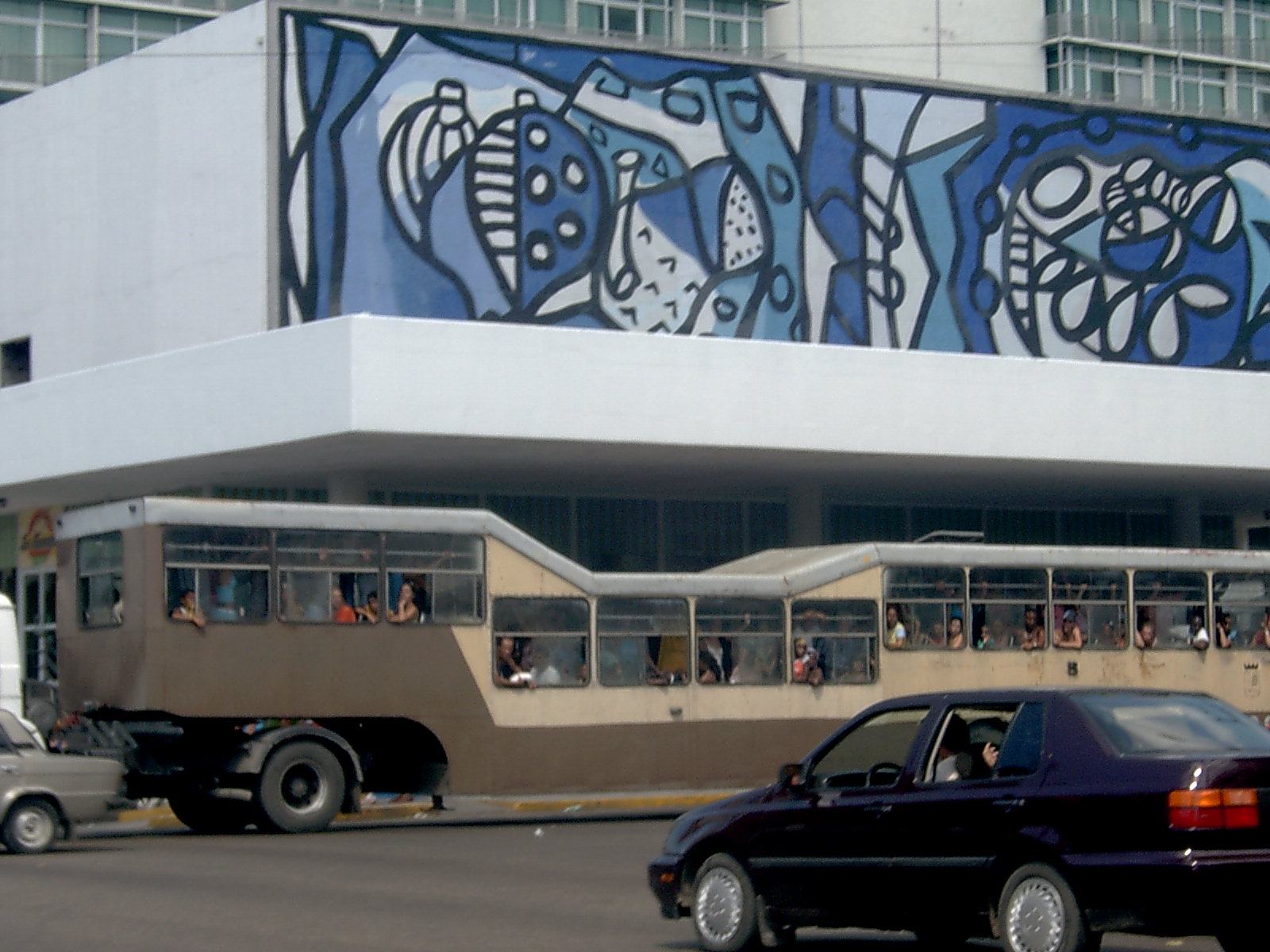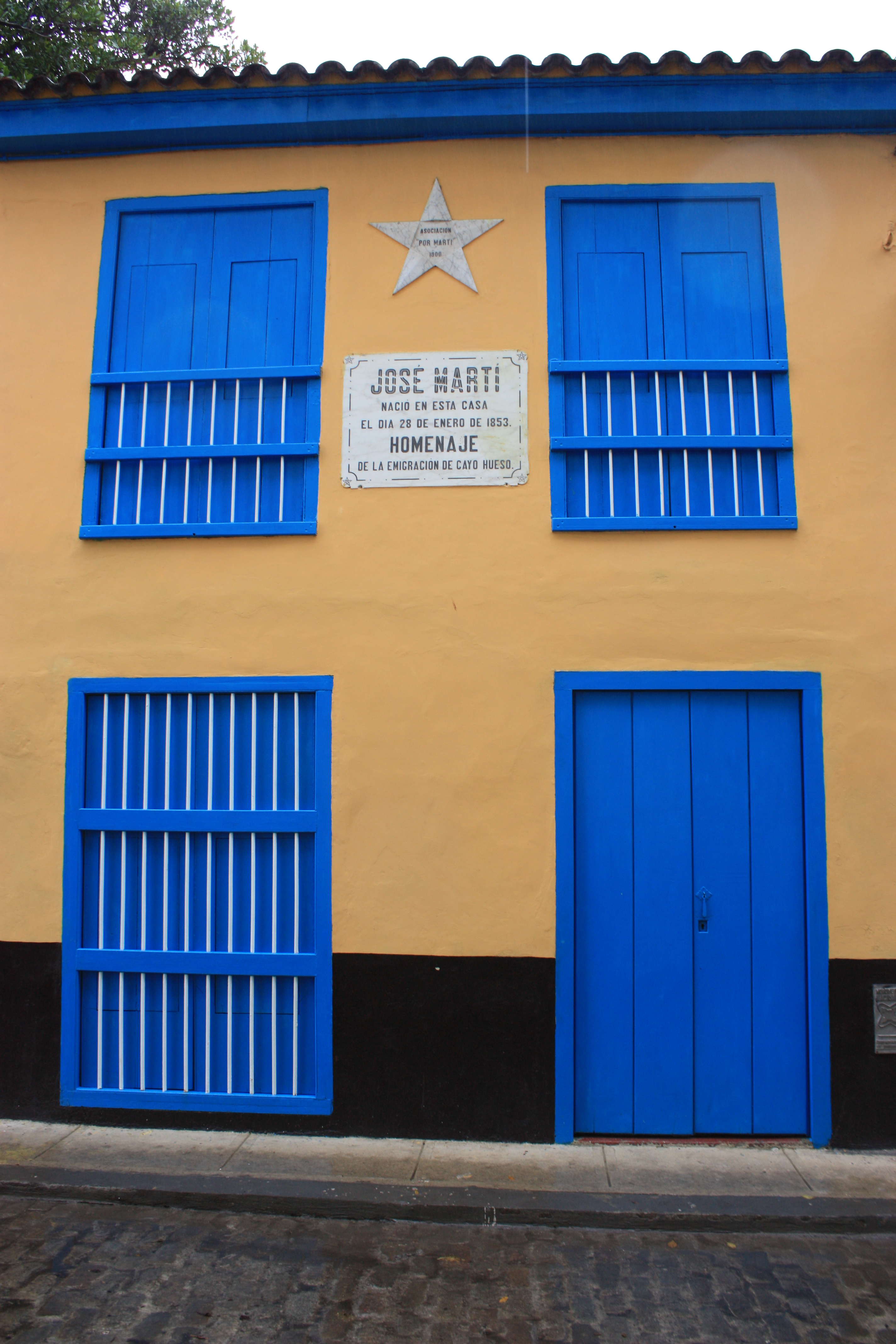|
Parque De Los Mártires
Parque de los Mártires (Martyrs Park) is a park in Santa Clara, Cuba. It is a few blocks from Parque del Carmen in front of Santa Clara railway station (Cuba), Santa Clara railway station. Overview A triangular shaped space with many points of interests. Its center piece is a truncated column, the only one in rural Cuba in honor of those fighters who lost their lives in the Independence War. 18th- and 19th-century buildings surround the park. The Railway Station is an example of colonial architecture, a building supposedly donated to the city by philanthropist Marta Abreu. Across from the station a colonial wooden family house still stands. Another important building in the park area is an art deco former Spanish garrison transformed in a school after the revolution. Its interior walls were considered the best example of The Vanguardist Movement Murals in Cuba. Cuban painter Amelia Peláez contributed to it, but the paintings have been almost completely lost. This building is a ... [...More Info...] [...Related Items...] OR: [Wikipedia] [Google] [Baidu] |
Parque Martires
*
*
{{dab, surname ...
Parque is the Galician, Portuguese and Spanish word for "park", and may refer to: * Parque (TransMilenio), a metro station in Bogotá, Colombia * Parque (Lisbon Metro), in Portugal * Parque (Santurce), a subbarrio in San Juan, Puerto Rico * Jim Parque, a baseball player See also * Parquetry, a type of flooring * Park (other) A park is an area of land with a recreational or other specific purpose. Park or Parks may also refer to: Places United Kingdom * Park (Reading ward), an electoral ward of the Borough of Reading, Berkshire, England * Park (Sefton ward), an el ... [...More Info...] [...Related Items...] OR: [Wikipedia] [Google] [Baidu] |
Santa Clara, Cuba
Santa Clara is the capital city of the Cuban province of Villa Clara Province, Villa Clara. It is centrally located in the province and Cuba. Santa Clara is the List of cities in Cuba, fifth-most populous Cuban city, with a population of nearly 250,000. History Santa Clara was founded by 175 people on July 15, 1689. 138 of them represented two large families already living in the area, who owned land next to the new city. The other 37 came from seven other families and included a priest and governor, all originating in the coastal city of San Juan de los Remedios. The population of Remedios, Cuba, Remedios had to choose between leaving their city, constantly being besieged by pirates, or staying. While most decided to stay, 37 people traveled south to the interior. On June 1, 1689, they arrived at a hill, joining two other families already present at the site. According to tradition, a mass was celebrated under a tamarind tree and Santa Clara was founded. Since then, the pla ... [...More Info...] [...Related Items...] OR: [Wikipedia] [Google] [Baidu] |
Parque Del Carmen
Parque del Carmen (Carmen's Park) is a park in Santa Clara, Cuba, which honors the city's founding. It is located in the ward (''reparto'') El Carmen, not too far from Martyr's Park and the railway station. Overview This old plaza is host to a small park centered by Saint Carmen's Church, a colonial building which originally also included the city's first school. In front of it, there is a gray marble monument surrounding a Tamarind tree indicating the foundation of Santa Clara. Each pillar supporting the bar represent the 7 families who moved to the site in 1689 from the town of Remedios near the north coast. Next to the Foundation is another monument which honors Captain Roberto Rodriguez, known as “El Vaquerito” (little cowboy), a young soldier who died in the Battle of Santa Clara. When notified of his death, revolutionary leader Che Guevara said: “Today it is like I have lost 300 men”. Gallery File:CUBA - SANTA CLARA - Iglesia de nuestra senora del carmen y tamari ... [...More Info...] [...Related Items...] OR: [Wikipedia] [Google] [Baidu] |
Santa Clara Railway Station (Cuba)
Santa Clara is the main railway station of the city of Santa Clara, seat of Villa Clara Province, Cuba. It is owned by the state company Ferrocarriles de Cuba (FFCC) and is located in front of '' Parque de los Mártires'' (Martyrs Park). It is one of the most important stations of Cuba and, along with Havana Central, Santiago and Camagüey, is a network's divisional headquarters. History Opened in 1860 as part of the Cienfuegos-Villa Clara railroad and named Paradero Villa Clara (Villa Clara station). The first building, a large wooden structure, burned to the ground in 1895, at that moment, it was rebuilt by Marta Abreu (benefactress of the city) and the city council decided to rename that building after her. This second building, a Colonial architecture structure of brick walls and red tiled roof, was again remodeled in 1925, for the one still standing, keeping the name of Marta Abreu. Due to that reason the station is also known as Estación Marta Abreu (''Santa Clara Marta ... [...More Info...] [...Related Items...] OR: [Wikipedia] [Google] [Baidu] |
Marta Abreu
Marta may refer to: People * Marta (given name), a feminine given name * Märta, a feminine given name * Marta (surname) :István Márta composer * Marta (footballer) (born 1986), Brazilian professional footballer Places * Marta (river), an Italian river that flows into the Tyrrhenian Sea * Marta, Lazio, a ''comune'' in Italy * Marta, Nepal, a village development committee Arts and entertainment * ''Marta'' (film), a 1971 Spanish film * "Marta" (Ricardo Arjona song), non-charting * "Marta", a song by Alejandra Guzmán, from the album ''Indeleble'' * "Marta" (Nena Daconte song) a song by Nena Daconte, No.6 in Spain * "Marta, Rambling Rose of the Wildwood", 1931 song by Arthur Tracy * "Marta," a song composed by Moisés Simons MARTA * Metropolitan Atlanta Rapid Transit Authority, the principal rapid-transit system in the Atlanta metropolitan area * Mountain Area Regional Transit Authority, the third largest regional transit agency in San Bernardino County, Califor ... [...More Info...] [...Related Items...] OR: [Wikipedia] [Google] [Baidu] |
Art Deco
Art Deco, short for the French ''Arts Décoratifs'', and sometimes just called Deco, is a style of visual arts, architecture, and product design, that first appeared in France in the 1910s (just before World War I), and flourished in the United States and Europe during the 1920s and 1930s. Through styling and design of the exterior and interior of anything from large structures to small objects, including how people look (clothing, fashion and jewelry), Art Deco has influenced bridges, buildings (from skyscrapers to cinemas), ships, ocean liners, trains, cars, trucks, buses, furniture, and everyday objects like radios and vacuum cleaners. It got its name after the 1925 Exposition internationale des arts décoratifs et industriels modernes (International Exhibition of Modern Decorative and Industrial Arts) held in Paris. Art Deco combined modern styles with fine craftsmanship and rich materials. During its heyday, it represented luxury, glamour, exuberance, and faith in socia ... [...More Info...] [...Related Items...] OR: [Wikipedia] [Google] [Baidu] |
Amelia Peláez
Amelia Peláez del Casal (5 January 1896 – 8 April 1968) was an important Cuban painter of the Avant-garde generation. Biography Amelia Peláez was born in 1896 in Yaguajay, in the former Cuban province of Las Villas (now Sancti Spíritus Province). She was the fifth born of eleven siblings in a family that was part of the Cuban-Creole middle class. Her father was a doctor, Manuel Pelaez y Laredo, and her mother, Maria del Carmen del Casal y Lastra, stayed at home with her children. Amelia's uncle was Julian del Casal, who was a poet and included her family in Cuba's intellectual circles. In 1917, her family moved to Havana, to the La Víbora district, and this gave her the opportunity to enter the Escuela Nacional de Bellas Artes "San Alejandro" at the rather late age of 20 years (students at this academy usually start at 12–13 years of age). She was among Leopoldo Romañach's favourite students. In 1924 she graduated from San Alejandro, and exhibited her paintings for the ... [...More Info...] [...Related Items...] OR: [Wikipedia] [Google] [Baidu] |
José Martí
José Julián Martí Pérez (; January 28, 1853 – May 19, 1895) was a Cuban nationalist, poet, philosopher, essayist, journalist, translator, professor, and publisher, who is considered a Cuban national hero because of his role in the liberation of his country from Spain. He was also an important figure in Latin American literature. He was very politically active and is considered an important philosopher and political theorist. Through his writings and political activity, he became a symbol of Cuba's bid for independence from the Spanish Empire in the 19th century, and is referred to as the "Apostle of Cuban Independence". From adolescence, he dedicated his life to the promotion of liberty, political independence for Cuba, and intellectual independence for all Spanish Americans; his death was used as a cry for Cuban independence from Spain by both the Cuban revolutionaries and those Cubans previously reluctant to start a revolt. Born in Havana, Spanish Empire, Martí began h ... [...More Info...] [...Related Items...] OR: [Wikipedia] [Google] [Baidu] |
Parque Vidal
Parque Vidal (also known by its previous names of Plaza Central and Plaza Mayor) is a park located in the center of Santa Clara, Cuba, covering an entire square block of the city. Due to its surrounding architecture, combining eclectic neo-classical and colonial-style buildings, as well as the large number of historic monuments dating from different historical periods, the park was designated as a National Monument in a ceremony in 1998. Monuments in the park The Glorieta gazebo in the center of the park, erected in 1911, still serves for weekly public concerts by the city's Philharmonic Band. North of the Glorieta is a bust of Leoncio Vidal, the War of Independence colonel who died on that spot fighting Spanish forces, and for whom the Park is named. Next to this bust is an obelisk, the first monument erected in the park, dedicated to the priest who migrated from the coastal town of Remedios with other families and founded the city. Between these monuments is a statue of “el ... [...More Info...] [...Related Items...] OR: [Wikipedia] [Google] [Baidu] |
Tourist Attractions In Santa Clara, Cuba
Tourism is travel for pleasure or business; also the theory and practice of touring, the business of attracting, accommodating, and entertaining tourists, and the business of operating tours. The World Tourism Organization defines tourism more generally, in terms which go "beyond the common perception of tourism as being limited to holiday activity only", as people "travelling to and staying in places outside their usual environment for not more than one consecutive year for leisure and not less than 24 hours, business and other purposes". Tourism can be domestic (within the traveller's own country) or international, and international tourism has both incoming and outgoing implications on a country's balance of payments. Tourism numbers declined as a result of a strong economic slowdown (the late-2000s recession) between the second half of 2008 and the end of 2009, and in consequence of the outbreak of the 2009 H1N1 influenza virus, but slowly recovered until the COVID-19 pa ... [...More Info...] [...Related Items...] OR: [Wikipedia] [Google] [Baidu] |


_interior.jpg)



